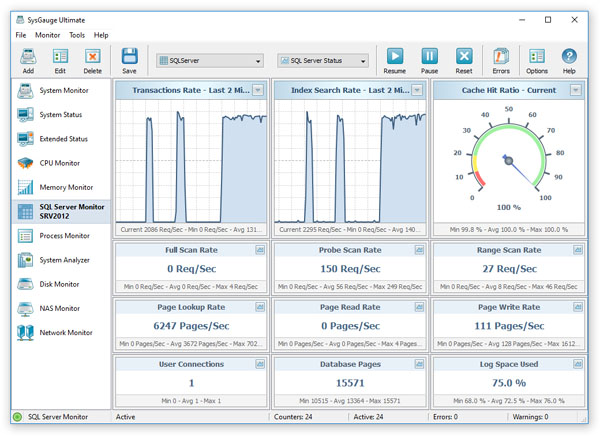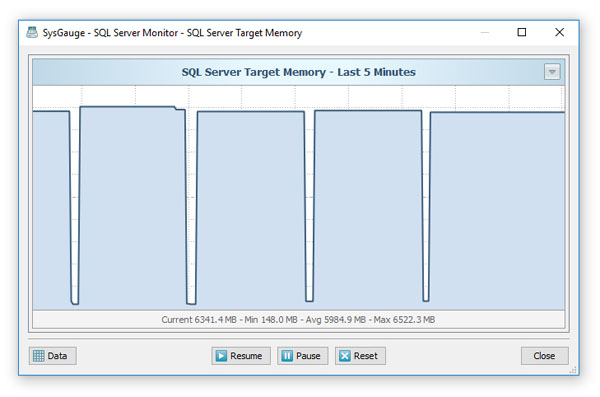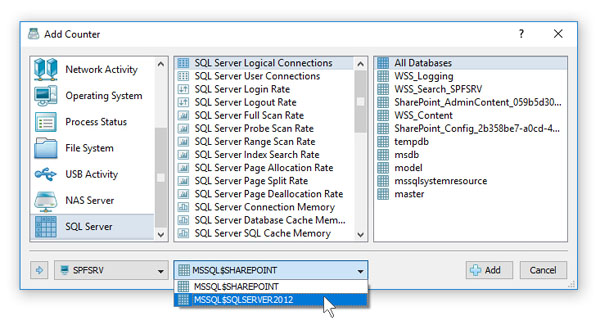 |
 |
SysGauge Ultimate allows one to monitor one or more Microsoft SQL Servers locally of via the network. In order to add an SQL Server monitor press the 'Add' button located in the top-left corner of the window and select the 'SQL Server Monitor' menu item. The SQL Server monitor provides the ability to monitor the SQL index search rate, SQL transaction rate, SQL cache hit ratio, SQL full scan rate, SQL probe scan rate, SQL range scan rate, SQL page lookup rate, SQL page read rate, SQL page write rate, SQL total memory, SQL database page count and the amount of used SQL log space. 
The user is provided with the ability to save SQL server monitoring reports into a number of standard formats including HTML, PDF, Excel, CSV, text and XML. In order to save an SQL server monitoring report, press the 'Save' button located on the main toolbar, select an appropriate report format, enter a report title and press the 'Save' button. 
For example, a PDF report includes the list of SQL server monitoring counters showing the average, minimum and maximum values for each counter and a number of line charts showing how the performance of the monitored SQL server was changing over time. SQL Server Memory Monitor The SysGauge SQL Server memory monitor GUI shows the SQL server total memory, the SQL Server cache memory, SQL Server target memory, SQL Server free memory, SQL Server stolen memory, SQL Server lock memory, SQL Server log pool memory, SQL Server granted work space memory, SQL Server maximum work space memory, SQL Server connection memory and the SQL Server optimizer memory. 
In order to open the history chart dialog for a specific SQL Server monitoring counter, press the 'Chart' button located in the top-right corner of the required counter. Under the history line chart, the history dialog shows the current counter value, the average counter value, the maximum counter value and the minimum counter value. In addition, the history dialog allows one to show the monitoring history for the last 1, 2 or 5 minutes. 
The history dialog provides the ability to export the monitoring data to a number of standard formats including HTML, PDF, Excel, text, CSV and XML. In order to save the history monitoring data, press the 'Data' button located in the bottom-left corner of the history dialog, press the 'Save' button and select an appropriate report format. SQL Server Monitoring Counters In addition to the dedicated SQL Server monitor, the user can use the customizable 'System Monitor' module to configure user-custom SQL Server monitoring profiles. In order to add an SQL Server monitoring counter, press the 'Monitor' button located on the main toolbar, selected the 'SQL Server' counters category in the left-side view and then select an appropriate SQL Server monitoring counter in the middle view. By default, SysGauge will monitor all SQL databases in the target SQL Server, but if required, the user can select a specific SQL database to monitor in the right-side view. In addition, in order to monitor a remote SQL Server via the network, press the 'Connect' button located in the bottom-left corner and specify the host name or an IP address of the remote computer to monitor. 
SysGauge Command Line Utility The SysGauge command line utility, which is available in SysGauge Ultimate and SysGauge Server product versions, provides the ability to monitor one or more SQL Servers and save SQL Server monitoring reports from batch files and shell scripts. The command line utility is located in the SysGauge 'bin' directory and it can be used to monitor the local system or remote servers via the network. In the simplest case, open a command prompt window, go to the SysGauge 'bin' directory and type the following command: sysgauge -sql_monitor -save_pdf_report <File Name or Directory> This command will perform an SQL Server monitoring operation using a number of SQL Server monitoring counters including the SQL Server transactions rate, cache hit ratio, index search rate, full scan rate, probe scan rate, range scan rate, page lookup rate, page read rate, page write rate, database pages, user connections, etc. In addition, after the monitoring operation will be completed, SysGauge will save a PDF SQL Server monitoring report to the specified file or directory. Command Line Options: -host <Remote Host Name or IP address> This option allows one to monitor remote SQL servers via the network. -sql_instance Normally, the SQL Server monitor will try to connect to the default SQL Server instance. This command line option provides the ability to specify which SQL Server instance to monitor allowing one to monitor multiple SQL Server instances installed on the local computer or a number of remote computers via the network. -time <Monitoring Time in Seconds> This command line option sets the maximum monitoring time. -silent This option enables the silent operation mode. -save_html_report <File Name or Directory> This command line option saves an HTML SQL Server monitoring report. -save_pdf_report <File Name or Directory> This command line option saves a PDF SQL Server monitoring report. -save_excel_report <File Name or Directory> This command line option saves an Excel SQL Server monitoring report. -save_text_report <File Name or Directory> This command line option saves a text SQL Server monitoring report. -save_csv_report <File Name or Directory> This command line option saves a CSV SQL Server monitoring report. -save_xml_report <File Name or Directory> This command line option saves an XML SQL Server monitoring report. -save_to_database <Table Name> This command line option saves monitoring results to the specified SQL database table. |
|